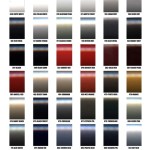Help Choosing Interior Paint Colors For Your Living Room
Selecting the right paint colors for a living room is a significant decision, as it greatly impacts the overall aesthetic and atmosphere of the space. The living room often serves as a central hub for relaxation, entertainment, and social interaction, making its appearance crucial. A well-chosen color palette can enhance the room's functionality and create a welcoming environment for both residents and guests. Navigating the vast array of paint options can be overwhelming, but by understanding fundamental principles of color theory and considering the existing features of the room, a suitable color scheme can be achieved.
The initial step in this process involves assessing the existing architectural elements and furnishings within the living room. Factors such as the amount of natural light, the size and shape of the room, the style of furniture, and the flooring material all play a role in determining the ideal paint colors. For instance, a room with limited natural light may benefit from lighter, more reflective hues to maximize brightness, while a larger room might be able to accommodate bolder, darker colors without feeling cramped. Similarly, the color and style of furniture should complement, rather than clash with, the chosen wall color.
Furthermore, it is important to consider the desired mood or feeling that the living room should evoke. Different colors have different psychological effects, and understanding these effects can help guide the selection process. Warm colors, such as reds, oranges, and yellows, tend to create a sense of energy, warmth, and intimacy. Cool colors, such as blues, greens, and purples, are generally associated with calmness, serenity, and relaxation. Neutral colors, such as whites, grays, and beiges, offer versatility and can be used to create a backdrop for other design elements.
Understanding Color Theory Basics
A foundational understanding of color theory is essential for making informed decisions about interior paint colors. Color theory encompasses the principles of how colors interact with each other and how they can be combined to create visually appealing and harmonious schemes. One of the core concepts is the color wheel, which illustrates the relationships between primary, secondary, and tertiary colors. Primary colors (red, yellow, and blue) cannot be created by mixing other colors, while secondary colors (green, orange, and purple) are created by mixing two primary colors. Tertiary colors are created by mixing a primary color with a neighboring secondary color.
Another important concept is color harmony, which refers to the pleasing arrangement of colors. Several common color harmonies can be employed in interior design, including complementary, analogous, and triadic color schemes. Complementary color schemes use colors that are opposite each other on the color wheel, such as blue and orange or red and green. These schemes create a high level of contrast and visual interest. Analogous color schemes use colors that are adjacent to each other on the color wheel, such as blue, blue-green, and green. These schemes create a more harmonious and subtle effect. Triadic color schemes use three colors that are equally spaced on the color wheel, such as red, yellow, and blue. These schemes offer a balance between contrast and harmony.
Furthermore, it is important to consider the concepts of color temperature and color saturation. Color temperature refers to the warmth or coolness of a color, as mentioned previously. Color saturation, also known as chroma, refers to the intensity or purity of a color. Highly saturated colors are vibrant and bold, while low-saturation colors are muted and subdued. The choice of color saturation can significantly impact the overall mood of the room. For example, a living room painted in highly saturated reds and oranges might feel energetic and stimulating, while a living room painted in low-saturation blues and greens might feel calming and relaxing.
Finally, the concept of color value, which refers to the lightness or darkness of a color, plays an important role. A color's value can be adjusted by adding white (to lighten it, creating a tint) or black (to darken it, creating a shade). Understanding the value of a color is important for creating contrast and depth in a room. For example, using a combination of light and dark shades of the same color can create a sense of dimension and prevent the room from feeling flat.
Analyzing the Living Room's Environment
Before selecting paint colors, a thorough assessment of the living room's existing environmental conditions is crucial. Understanding the amount and type of natural light the room receives, the size and shape of the space, and the existing architectural features will inform the color selection process. The direction the room faces significantly affects the way natural light enters. South-facing rooms typically receive warm, bright light throughout the day, while north-facing rooms receive cooler, more diffused light. East-facing rooms receive warm morning light and cooler afternoon light, while west-facing rooms receive cooler morning light and warm afternoon light.
The size and shape of the living room also influence the choice of paint colors. Smaller rooms generally benefit from lighter colors, which can create the illusion of more space. Darker colors can make a small room feel even smaller and more enclosed. However, in larger rooms, darker colors can be used to create a sense of intimacy and warmth. The shape of the room should also be taken into consideration. For example, in a long, narrow room, painting the shorter walls a darker color than the longer walls can help to visually shorten the room and create a more balanced appearance.
Existing architectural features, such as fireplaces, built-in bookshelves, and crown molding, should also be considered. These features can serve as focal points in the room, and the paint colors should be chosen to complement them. For example, if the living room has a prominent fireplace made of natural stone, the wall colors should be chosen to harmonize with the colors in the stone. Similarly, if the living room has intricate crown molding, the molding can be painted a contrasting color to highlight its details.
Furthermore, the existing furniture and flooring should be taken into account. The color and style of the furniture should complement the wall colors. For example, if the living room furniture is upholstered in neutral colors, the wall colors can be used to add a pop of color and create visual interest. However, if the furniture is already brightly colored, the wall colors should be more neutral to avoid overwhelming the room. The color of the flooring should also be considered. For example, if the living room has dark hardwood floors, lighter wall colors can help to brighten the room and create a sense of balance.
Considering the Desired Mood and Functionality
The desired mood or atmosphere that the living room should evoke is another critical factor to consider when selecting paint colors. The living room often serves multiple functions, acting as a space for relaxation, entertainment, and social interaction. Therefore, the chosen color palette should reflect these diverse needs. Individuals should reflect upon the primary intended use of the living room and the desired emotional impact. If the goal is to create a relaxing and serene environment, cool colors such as blues, greens, and purples may be suitable. These colors are associated with calmness, tranquility, and peace, making them ideal for creating a space where one can unwind and de-stress.
Conversely, if the aim is to create a more energetic and stimulating environment, warm colors such as reds, oranges, and yellows may be more appropriate. These colors are associated with energy, excitement, and passion, making them ideal for creating a space where one can entertain guests or engage in creative activities. However, it is important to use warm colors sparingly, as they can be overwhelming if used excessively. A balanced approach, incorporating both warm and cool colors, can be effective in creating a dynamic yet harmonious atmosphere.
Neutral colors, such as whites, grays, and beiges, offer versatility and can be used to create a backdrop for other design elements. These colors are often used as a base for a color scheme, allowing other colors to take center stage. Neutral colors are also ideal for creating a sense of spaciousness and lightness in a room. They can be paired with bolder accent colors to add visual interest and personality. Furthermore, the functionality of the living room should also be considered. If the living room will be used primarily for watching television, darker colors may be preferable, as they can reduce glare and create a more immersive viewing experience. However, if the living room will be used primarily for reading, lighter colors may be more suitable, as they can provide better illumination and reduce eye strain.
Ultimately, the choice of paint colors should reflect the personal preferences and lifestyle of the individuals who will be using the living room. By carefully considering the various factors outlined above, a color scheme can be selected that enhances the room's functionality, creates the desired mood, and reflects one's individual style.

How To Choose Paint Colors For Your Entire House The Decorholic

74 Best Living Room Paint Color Ideas For 2025

How To Choose A Paint Color The Home Depot

Choosing Interior Paint Colors Riggins Painting
:max_bytes(150000):strip_icc():format(webp)/GettyImages-LivingRoomColors-56f0d51e3df78ce5f83b802e.jpg?strip=all)
Tips For Choosing Interior Paint Colors Holmes St Clair

30 Living Room Paint Colours Inspiration For An Inviting Space Benjamin Moore

Do You Know How To Pick Paint Color For Your Rooms Courtney Warren Home

Choosing Interior Paint Colors 5 Tricks You Should Know

How To Choose A Wall Color In The Living Room Pottery Barn

How To Choose Paint Colors Tips Follow And Mistakes Avoid This Old House
Related Posts








